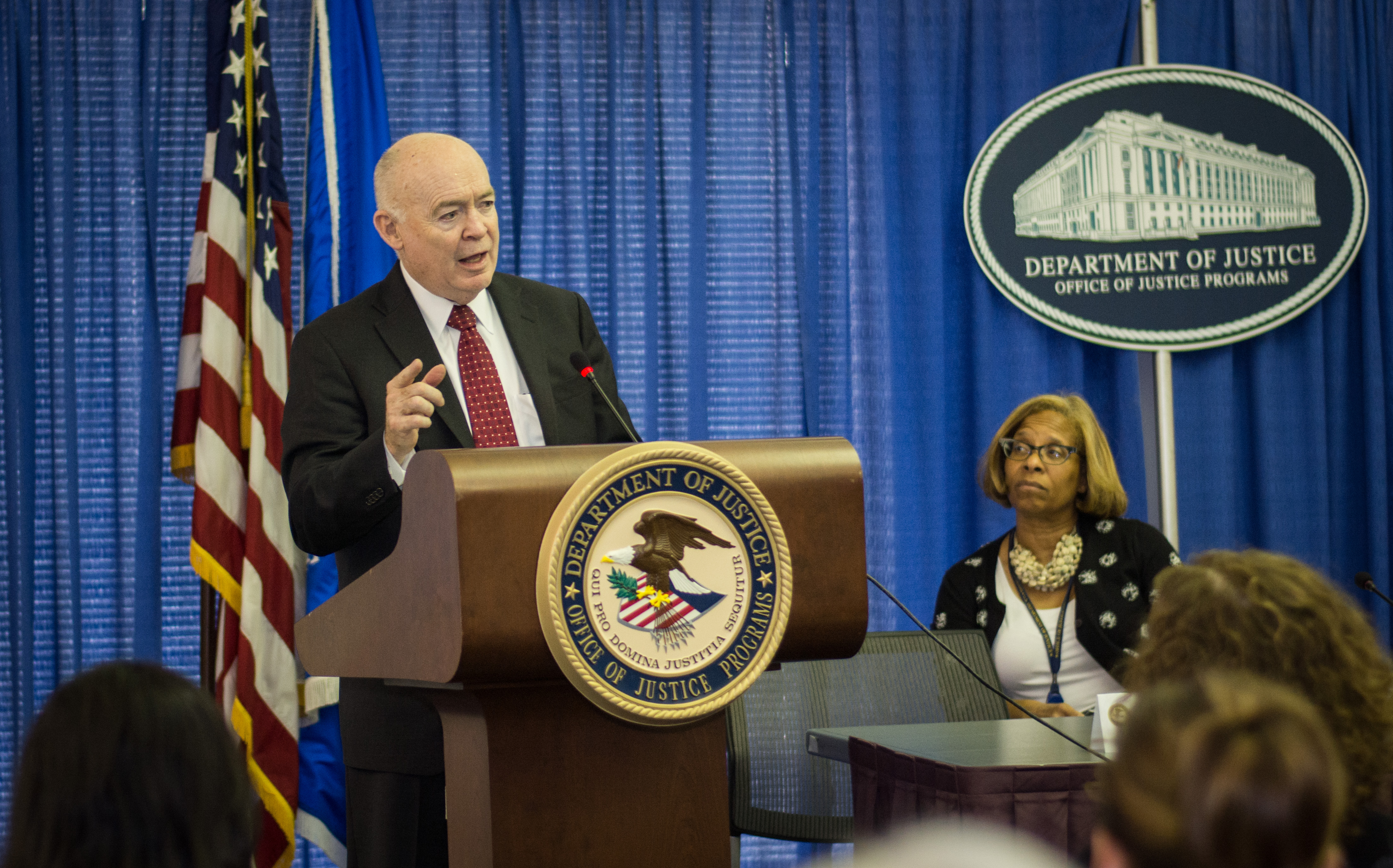Related Content
Press Release
This is archived content from the U.S. Department of Justice website. The information here may be outdated and links may no longer function. Please contact webmaster@usdoj.gov if you have any questions about the archive site.
Courtesy of Assistant Attorney General John C. Cruden for the Environment and Natural Resources Division and Assistant Attorney General Karol Mason for the Office of Justice Programs
“We feel safer if they are safe.” This was a sentiment voiced during a recent roundtable discussion on Animal Welfare Enforcement that the Environment and Natural Resources Division (ENRD) and Office of Justice Programs hosted at the Justice Department. This statement reflects a view that there is a link between certain types of animal cruelty and interpersonal abuse and that harm to animals also harms communities. This concept is not new. What is new and encouraging is the dialogue that it spurred among federal, state and local law enforcement leaders about how we can more effectively work together and learn from each other to combat animal cruelty.
We were joined by more than 100 leaders in the area, including representatives of federal agencies, states and local governments, as well as researchers, scientists and others in the animal welfare field. And for the first time, we focused collectively on information sharing, organizational strategies and cooperation in animal welfare enforcement.
Unlike some of the traditional environmental and pollution-control statutes, which contain formal mechanisms for cooperative federalism, animal welfare law is dominated by a loose interplay of both mutually exclusive areas of enforcement and areas of co-extensive regulation. At the federal level, laws like the Animal Fighting Venture Prohibition and the Animal Crush Video Statute prohibit extreme acts of violence and cruelty, while laws like the Animal Welfare Act, Horse Protection Act and Humane Slaughter Act, establish humane standards for common commercial activities. But these federal laws represent only one facet of the legal system governing animal welfare in the United States. States and local governments have had a long history of regulating animal cruelty. Today every state has its own animal cruelty laws. These laws sometimes overlap with federal law, but many of them are broader and cover areas like animal neglect, hoarding, abuse and killing. Criminal activity like animal fighting, where enforcement authority lies with multiple jurisdictions, presents an obvious need for cooperation and communication between authorities. But the need does not end there.
Information Sharing

The first topic of our roundtable emphasized the importance of and current challenges in, information sharing. Many have described the link between animal cruelty and other crimes, such as domestic violence, gang activity and narcotics and gun trafficking. Indeed, the department explored this issue in a 2013 gathering examining the intersection between animal cruelty and public safety. But until very recently, we lacked a mechanism for consistently collecting and sharing information about animal cruelty crimes on a nationwide basis. Beginning this year, however, through its National Incident-Based Reporting System (NIBRS), the FBI began collecting detailed data from participating law enforcement agencies across the country on acts of animal cruelty. By including animal cruelty crimes as a distinct category in NIBRS, the department will get a better picture of animal cruelty crime across the country. But the information that we collect is only as good as what gets reported to us. So we need more jurisdictions to participate in NIBRS and report animal cruelty crimes.
Organization
We also explored how different states and localities have organized themselves to more effectively address the unique challenges raised in this specialized field. In 2015, for example, the Virginia Attorney General’s Office designated one of the first Animal Law Units in the nation, where a knowledgeable team of staff attorneys serve as a resource for local law enforcement and state agencies on animal welfare issues. In Delaware, the state created the Office of Animal Welfare to consolidate and coordinate the companion animal programs in the state. And earlier this year, the District Attorney’s Office in Queens County became the first in New York City to create an Animal Cruelty Prosecutions Unit.
Here at the Department of Justice, we have also recently examined our approach to animal welfare litigation, resulting in the designation of ENRD as the component responsible for coordinating judicial enforcement efforts and working on civil and criminal animal welfare cases along with the U.S. Attorneys’ Offices. We recently charged and arrested nine individuals for their alleged involvement in a multi-district dogfighting conspiracy. We also testified before the U.S. Sentencing Commission in support of increasing the recommended sentencing guidelines for those who perpetuate this blood sport.
Continued Cooperation
During our roundtable, we had a chance to hear law enforcement personnel share their stories on collaboration and partnership across state lines. Representatives of the FBI’s Columbia, South Carolina, Violent Gang Task Force, which consists of agents of the FBI, Columbia Police Department, the Richland County Sheriff’s Office, the South Carolina Law Enforcement Division and the South Carolina National Guard, discussed their recent enforcement actions.
This joint federal-state task force model, where local police are deputized to work alongside federal officials, highlights one successful way multiple jurisdictions can tackle complex enforcement challenges together. The task force was able to effectively take down a dogfighting operation through what began as a joint investigation of drug activity. But building cooperative law enforcement relationships can take many other forms, whether it is sharing information about conduct which offends the laws of multiple governments – such as the creation and distribution of animal crush fetish videos – or making referrals in cases where a violation may be more appropriately addressed by a single jurisdiction, such as with inhumane handling of animals outside of a USDA-regulated facility.
Animals are a part of our community and the laws that are designed to keep them safe serve a number of purposes, including curbing violent behavior more generally. By leading this dialogue among federal, state and local law enforcement, we can more effectively combat animal cruelty and improve public safety.